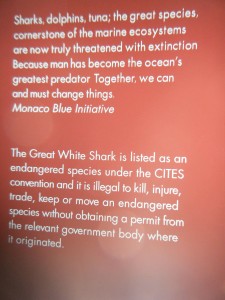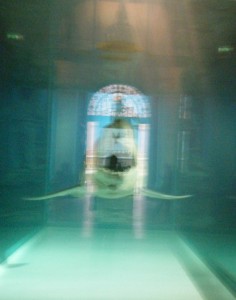International affairs correspondent John Kelly travels between Monaco and Melbourne and discovers a world of strange equivalences…
I fly from Australia to Ireland to pick up Christina and Oscar before heading down to Monaco to watch some tennis, a welcome family holiday after a month on the road. One of the movies on the long-haul sector happens to be An Affair to Remember, during which Cary Grant stops at Villefranche before setting off on his voyage to New York. As we pass I look down on this village, a cruise ship the size of a large apartment block is in the bay. This section of road is named after another Hollywood great, Grace Kelly. She later became Princess Grace of Monaco and sadly died in a car crash. I realize it is just as ironic that Melbourne has a swimming pool named after the Prime Minister, Harold Holt who drowned, and that I find Damian Hirst in an aquarium further along the Grande Corniche.
We arrive at the tennis stadium and I am thinking that Melbourne and Monaco have a few things in common, just as Locky Morris’s dog and a table share visual similarities, as brought to my attention by the Dublin gallery, Mother’s Tank Station (MTS), via e-mail on the 1st April. It’s drawing together of coincidental relationships was obviously intended with humour:
“… Morris notes the incredible physical resemblance of a family pet, lying prone with its legs in air, to an upturned outdoor plastic chair… The equivalence of dog = chair is perfectly formed by the tonal gradation towards the up-ended ‘underarms’ of both, and most particularly the resemblance of the chair’s curvature and drainage point to the dog’s tummy and poochey penis.
I continue to ponder the dog photo as the tennis player P. Luczak from Australia question a line call on the centre court at the Monte Carlo Masters. Luczak loses the first three games and he looks hopelessly outclassed. Although the match is one-sided the clarity of the light makes the experience a vivid one with the blue sky and azure sea set against the red clay courts and their dark green backdrops. Behind the clubhouse a rocky cliff climbs dramatically, and a glass apartment building hangs precariously over the edge looking like a model from Thunderbirds. Oscar later remarks that it is much better in real life than on TV! Thinking the tennis a mismatch, we decide to wander around.
We end up at the dramatic Oceanographic Museum in the old town of Monaco. The museum also sits atop a cliff that drops down into the Mediterranean Sea and we see the Hirst exhibition titled Cornucopia that includes two large ‘shark’ tanks and acres of butterfly paintings along with some industrial-scale spin and dot paintings. One of the sharks is appropriately juxtaposed against an old whaling boat complete with harpoon used by Prince Albert 1st for his ‘scientific’ explorations.
There would seem to be obvious reasons why such a museum, that includes an aquarium, might exhibit an artist whose cleverly branded fame is based on a dead shark and his name always being associated with vast amounts of money. It would seem a perfect fit for Monaco and this institution “…whose only resources …come from the entrance fees paid by the public, and the shop and restaurant.” [This quote is taken from the Guide to the Oceanographic Museum Monaco]. If ever an artist was sure to reel in the punters in an aquarium it is Hirst, however, it seems, unlike Morris, he does not want his reality reproduced, for a sign states categorically that no photographs are to be taken of his work, a directive happily ignored by most.
Just as the Princess Grace Boulevard and the Harold Holt swimming pool sound ironic, Hirst’s work is juxtaposed next to a sign that tells us:
Sharks…the great species, cornerstone of the marine ecosystems, are now truly threatened with extinction because man has become the ocean’s greatest predator Together, we can and must change things.
One might assume that an oceanographic museum’s role is the conservation of marine life, which creates an even more bizarre relationship with Hirst’s art that quite clearly kill sharks. As we know brands require a consistency and repetitiveness so that the manufactured image is consistently reinforced, which means Hirst is an ongoing danger to marine life. We do not allow animals to be harmed in the making of films or even a reality show where one was recently fined when the contestants killed a rat and ate it all in the chase for ratings. Viewers = the advertising dollar. In this context, why do we allow art to debase itself by killing animals for the amusement of a museum audience? An institution that sees itself as a protector of marine life!
It might be argued that Hirst is only responding to mankind’s desire to confront reality, reproduced or not, and this is no more so than in contemporary life. Think of the evolution of cameras and TV from black and white to colour to HD and soon to be available generally in 3-D, all in response to consumer demand for greater realism in things like sport, movies and even art. Hirst’s real ‘dead’ sharks are one example, but I only need to think back a few weeks when I was at the National Gallery of Victoria (NGV) in Australia to find another.
Then I stood looking at a Lilliputian man in a boat not dissimilar to the one Prince Albert 1st used in Monaco, but without the harpoon. Whilst there I bumped into a friend who told me that she had learned that the boat might be an allusion to a vagina and the small man sitting inside represents the clitoris. I was slightly taken aback at my friend’s suggestion for most of Ron Mueck’s exhibition looks like it has escaped from the G-rated Madame Taussauds in London. I pondered the bizarre thought that an artist who deals with hyper realism would need to allude to a vagina rather than create a realistic looking one, but then if you look at this exhibition the vaginas are always covered where as the male genitals are often shown in all their flaccid realism. It seems that Mueck eschews realism at some level so that just like Morris’s dog = chair, maybe Mueck’s man in boat does actually = vagina.
Mueck’s hyper-realistic human sculptures came to prominence in the exhibition Sensation in 1999 at the Royal Academy when Charles Saatchi exhibited his collection of YBA’s (Young British Artists) including Hirst’s original dead Shark (that eventually rotted and had to be replaced by another). Mueck was included with Dead Dad, a sculpture that greets visitors to his exhibition in Melbourne. Dead Dad uses scale and realism to unsettle us and he achieves it by making us believe we are looking at what might be a real dead body. He does something similar with a giant woman covered by a sheet in bed that does not work nearly as well for it looks like something from a department store’s Christmas window. Dead Dad, is also cheapened by another similar figure, but this time he is laid out on an inflatable waterbed, drink in hand, floating on a blue wall as if on the Cote d’Azur. It is similar to the figure on a billboard in the film Jaws where some wag paints a shark fin in the background.
I head back to the tennis in Monaco where I see two people arm in arm; one a man, maybe in his late sixties, short, grey hair and impeccably dressed; the other a woman who is young, tall, blonde and towers over him. They walk slowly looking something akin to a Monaco stereotype; ageing rock star with supermodel ‘daughter’ or potentially a Mueck sculpture combining his penchant for playing with scale. It makes me think that Hirst and Mueck should collaborate, Hirst ordering the tanks and publicity and Mueck making the sharks, so that our marine life might be better protected. It could even lead to a bigger shark!
Of the rest of Mueck’s exhibition the most interesting were two small elderly ladies in coats, looking like they were having a good old gossip. It reminded me of William Dobell’s painting from the 1930’s, Mrs South Kensington. It takes us back to the debate that surrounded the Joshua Smith court case in 1944. During that time the art world split into two camps; one, labelled the ‘conservatives’ who argued vehemently that art required realism and the closer to reality the better, and the other were those who were prepared to deviate from reality, these people were labelled ‘modernists’. It is generally accepted that with Dobell’s victory in the court case modernism won, however Mueck’s exhibition coming hot on the heels of the recent Ricky Swallow exhibition that also explored a hyper-realism in 3-D, suggests the conservatives at the NGV have played the long game just like the tennis player Luczak in Monte Carlo who came back to win in three sets. It is simply the medium that has changed, for if a painter painted a table full of dead fish ala Swallow, or a dead figure in a super realistic slick manner it would quite rightly be regarded as somewhat banal, or would be seen as simply an inferior reworking of Flemish still-life painting or Rembrandt’s The anatomy lesson of Dr. Nicolaes Tulp (1632), respectively. The difference being the 3-D model is made possible by technological advances in contemporary materials and techniques and it is presented under the cover of a post-modernity where anything goes as long as it sells tickets. Realism whether hyper or simply hyped = visitors = money = museum funding or ironically in Hirst’s case marine research!
We return to the airport and I think of another artist, Antoine de Saint-Exupéry whom Lyon named their airport after. Unfortunately like Holt, and Grace Kelly he is also dead, killed in a plane crash. Strangely Melbourne’s airport used to have a sculpture of Icarus in its arrivals hall and like Monaco now has a casino at its heart. Maybe as the saying goes: the art-world is a carnival with a casino attached.



Pingback: Tweets that mention From Melbourne to Monaco via Princess Grace Boulevard | -- Topsy.com
That museum in Monaco is a poor excuse for a natural history museum. It’s like they wanted to give the impression that Monaco is more than gambling, tax havens and vintage boat shows. The museum is just a depressing schamozzle.